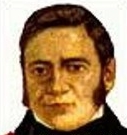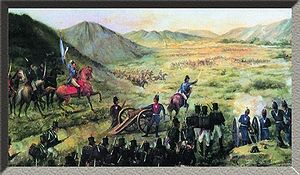
Pío de Tristán
Encyclopedia

Arequipa
Arequipa is the capital city of the Arequipa Region in southern Peru. With a population of 836,859 it is the second most populous city of the country...
Peru
Peru
Peru , officially the Republic of Peru , is a country in western South America. It is bordered on the north by Ecuador and Colombia, on the east by Brazil, on the southeast by Bolivia, on the south by Chile, and on the west by the Pacific Ocean....
—August 24, 1860, Lima
Lima
Lima is the capital and the largest city of Peru. It is located in the valleys of the Chillón, Rímac and Lurín rivers, in the central part of the country, on a desert coast overlooking the Pacific Ocean. Together with the seaport of Callao, it forms a contiguous urban area known as the Lima...
) was a Peruvian general and politician. He was nominally the last Spanish viceroy of Peru, serving in that capacity from December 1824 to January 23, 1826, but not exercising power.
Born in Peru, Tristán y Moscoso went to Spain
Spain
Spain , officially the Kingdom of Spain languages]] under the European Charter for Regional or Minority Languages. In each of these, Spain's official name is as follows:;;;;;;), is a country and member state of the European Union located in southwestern Europe on the Iberian Peninsula...
, where he fought the French in the War of the Convention
War of the Pyrenees
War of the Pyrenees refers to the Pyrenees front of the First Coalition's war against the First French Republic. Also known as Great War, War of Roussillon, or War of the Convention, it pitted Revolutionary France against the kingdoms of Spain and Portugal from March 1793 to July 1795 during the...
(1793–1795). On his return to Peru he was elected alcalde (mayor) of Arequipa (1808). He was a general in the Royalist army in Peru. In June 1811 he fought as part of the victorious Royalist forces in the Battle of Guaqui.
He led a Royalist force into the territory of present-day Argentina
Argentina
Argentina , officially the Argentine Republic , is the second largest country in South America by land area, after Brazil. It is constituted as a federation of 23 provinces and an autonomous city, Buenos Aires...
after the Battle of Guaqui. He was defeated at Tucumán and Salta
Salta
Salta is a city in northwestern Argentina and the capital city of the Salta Province. Along with its metropolitan area, it has a population of 464,678 inhabitants as of the , making it Argentina's eighth largest city.-Overview:...
, by one of his classmates at Salamanca
Salamanca
Salamanca is a city in western Spain, in the community of Castile and León. Because it is known for its beautiful buildings and urban environment, the Old City was declared a UNESCO World Heritage Site in 1988. It is the most important university city in Spain and is known for its contributions to...
, rebel General Manuel Belgrano
Manuel Belgrano
Manuel José Joaquín del Corazón de Jesús Belgrano , usually referred to as Manuel Belgrano, was an Argentine economist, lawyer, politician, and military leader. He took part in the Argentine Wars of Independence and created the Flag of Argentina...
. The Battle of Salta
Battle of Salta
The Battle of Salta took place on February 20, 1813 on the plains of Castañares, near the present-day Argentina city of Salta, during the Argentine War of Independence. The Army of the North, under the command of general Manuel Belgrano, defeated for the second time the royalist troops of general...
took place on February 20, 1813. Belgrano had been sent by the Second Triumvirate (of insurgents in Buenos Aires
Buenos Aires
Buenos Aires is the capital and largest city of Argentina, and the second-largest metropolitan area in South America, after São Paulo. It is located on the western shore of the estuary of the Río de la Plata, on the southeastern coast of the South American continent...
) to attack the city, at the northern extremity of the old Viceroyalty of Rio de la Plata
Viceroyalty of the Río de la Plata
The Viceroyalty of the Río de la Plata, , was the last and most short-lived Viceroyalty of the Spanish Empire in America.The Viceroyalty was established in 1776 out of several former Viceroyalty of Perú dependencies that mainly extended over the Río de la Plata basin, roughly the present day...
. This he did, completely defeating the troops of Tristán. It was the first military victory achieved under the flag of Argentina.

Charcas
Charcas may refer to:* Charcas Province, a province in Potosí Department, Bolivia* Real Audiencia of Charcas, one of six political units of the Viceroyalty of Peru* Charcas, a historical name of Sucre, capital of Bolivia...
, Potosí
Potosí
Potosí is a city and the capital of the department of Potosí in Bolivia. It is one of the highest cities in the world by elevation at a nominal . and it was the location of the Spanish colonial mint, now the National Mint of Bolivia...
and later Cochabamba
Cochabamba
Cochabamba is a city in central Bolivia, located in a valley bearing the same name in the Andes mountain range. It is the capital of the Cochabamba Department and is the fourth largest city in Bolivia with an urban population of 608,276 and a metropolitan population of more than 1,000,000 people...
, Alto Perú (now Bolivia). At the expiration of the truce, General Belgrano followed Tristán into Alto Perú, entering the territory of Charcas on May 7, 1813. However, Belgrano was defeated at Vilcapugio
Battle of Vilcapugio
The Battle of Vilcapugio was an action fought on October 1, 1813 during the second Campaign of Upper Peru in the Argentine War of Independence, where the republican forces led by General Manuel Belgrano were defeated by a pro-Spanish royalist army, led by Joaquin de la Pezuela.The campaign was...
on November 1, and again at Ayohuma
Battle of Ayohuma
The Battle of Ayohuma was an action fought on 14 November 1813, during the second Upper Peru Campaign of the Argentine War of Independence...
on November 14.
The December 1824 defeat of Viceroy José de la Serna in the Battle of Ayacucho
Battle of Ayacucho
The Battle of Ayacucho was a decisive military encounter during the Peruvian War of Independence. It was the battle that sealed the independence of Peru, as well as the victory that ensured independence for the rest of South America...
effectively ended Spanish power in Peru. Tristán was the most senior Spanish military officer in the colony, and as such he assumed the office of provisional viceroy, solely for the purpose of transferring power to the nationalists.
After this, he chose to stay in Peru, and was active in Peruvian politics. He exercised the functions of prefect and commander in Arequipa. Then he was Peruvian minister of war and marine. He participated in the creation of the Peruvian-Bolivian Confederation
Peru-Bolivian Confederation
The Peru–Bolivian Confederation was a short-lived confederate state that existed in South America between 1836 and 1839. Its first and only head of state, titled Supreme Protector, was the Bolivian president, Marshal Andrés de Santa Cruz....
and served as its foreign minister. From October 12, 1838 to February 23, 1839 he was president of the state of South Peru within the Confederation. He died in Lima in 1860.
He is described by his niece, Flora Célestine Tristán
Flora Tristan
Flora Tristan was a socialist writer and activist. She was also one of the founders of modern feminism...
, in her travel book Pérégrinations d'une paria (Peregrinations of a Pariah, 1838). Flora Tristán was the grandmother of French painter Paul Gauguin
Paul Gauguin
Eugène Henri Paul Gauguin was a leading French Post-Impressionist artist. He was an important figure in the Symbolist movement as a painter, sculptor, print-maker, ceramist, and writer...
.

